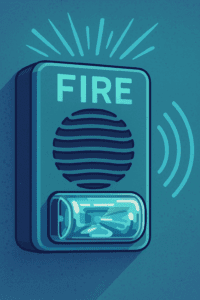A fire in a large building can be frightening and dangerous. According to the NFPA, U.S. fire departments respond to a structure fire every 23 seconds on average. A properly functioning fire alarm system, including horn strobes, is crucial for protecting occupants and ensuring safe evacuations.
Table of Contents
- What is a Horn Strobe?
- How Does a Horn Strobe Work?
- Proper Placement and Installation Guidelines
- Why Include a Horn Strobe in Your Fire Alarm System?
- Regulatory Compliance: ADA and NFPA Standards
- Frequently Asked Questions
- Contact Cunningham Security for Installation and Inspection
What is a Horn Strobe? What is its Purpose?
A horn strobe combines an audible horn alarm and a visual strobe light. When activated by a fire alarm system, the horn emits a loud noise, alerting occupants to evacuate, while the strobe emits powerful flashing lights, visible from a distance, providing critical visual notification.
The visual component ensures occupants who are hearing impaired or working in noisy environments are alerted promptly. The primary goal of the horn strobe is immediate occupant awareness, facilitating swift evacuation in emergencies.
How Does a Horn Strobe Work?
A horn strobe is activated automatically when a fire alarm system detects an emergency condition, either via smoke detectors, heat detectors, or manual pull stations. Upon activation, the horn produces an alarm sound, while the synchronized strobe lights flash consistently, providing both auditory and visual notifications simultaneously.
detectors, or manual pull stations. Upon activation, the horn produces an alarm sound, while the synchronized strobe lights flash consistently, providing both auditory and visual notifications simultaneously.
These strobes emit synchronized flashes at specific frequencies and brightness levels, which can be customized based on the type and size of the building. By ensuring a clear and unmistakable indication of an emergency, horn strobes significantly enhance occupant safety, particularly in large or noisy environments such as factories, schools, hospitals, and office buildings.
Proper Placement and Installation Guidelines
Proper placement of horn strobes is crucial to maximize visibility and audibility. According to NFPA standards, strobes must be clearly visible and audible in all occupied spaces.
Wall-Mounted vs. Ceiling-Mounted Horn Strobes
Wall-mounted horn strobes are ideal for rooms with high ceilings, as ceiling-mounted strobes typically cannot exceed 30 feet in height. Conversely, ceiling-mounted strobes can effectively cover areas where wall-mounted strobes could be obstructed by furniture or other structures.
NFPA Placement Guidelines
- Strobes must be placed within 6 inches of the ceiling in non-sleeping areas and within 24 inches in sleeping areas.
- Install strobes in public areas including hallways, restrooms, conference rooms, classrooms, and lobbies.
- Ensure visual coverage is indirect, meaning occupants can see strobe reflections off walls and surfaces even if not facing the device directly.
Adhering strictly to these guidelines ensures comprehensive coverage and safety for all occupants.
Why Include a Horn Strobe in Your Fire Alarm System?
Horn strobes significantly enhance the effectiveness of fire alarm systems by providing dual notification methods: sound and sight. This redundancy is particularly crucial for ensuring safety in diverse environments.
Many individuals, especially those who are hearing impaired or working in loud industrial environments, depend primarily on visual alerts. Additionally, integrating horn strobes ensures compliance with regulatory requirements, reducing liability and enhancing safety.
Regulatory Compliance: ADA and NFPA Standards
The Americans with Disabilities Act (ADA) of 1990 mandates accessible public spaces and accommodations, explicitly requiring visual alert systems like horn strobes for hearing-impaired individuals. NFPA standards reinforce these requirements, outlining precise specifications for strobe intensity, synchronization, and placement to ensure safety and accessibility.
Failure to comply can result in severe penalties, increased liability risks, and compromised safety, underscoring the importance of understanding and adhering to these guidelines.
Frequently Asked Questions
What is the required brightness for horn strobe lights?
NFPA 72 outlines required strobe intensities based on room size and layout. Generally, strobes range from 15 to 110 candela, with higher intensities for larger spaces or high ambient light conditions.
How often do horn strobes need testing?
Horn strobes should be tested annually as part of your comprehensive fire alarm inspection, ensuring both the audible and visual components function correctly.
Can I install horn strobes myself?
Installation should be performed by certified professionals due to precise regulatory requirements, technical specifications, and the critical nature of these life-safety devices.
Contact Cunningham Security for Installation and Inspection
Cunningham Security is a leading provider of fire safety solutions, with extensive expertise in installing and inspecting horn strobes and complete fire alarm systems. Our certified technicians ensure compliance with all ADA and NFPA requirements, providing peace of mind and unparalleled safety.
Ready to enhance the fire safety of your property? Contact Cunningham Security today to schedule a consultation and ensure your building’s compliance and safety. Call us at (207) 846-3350 or visit our contact page here.
